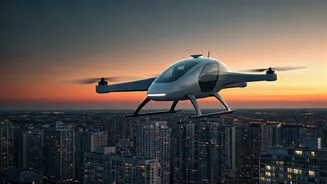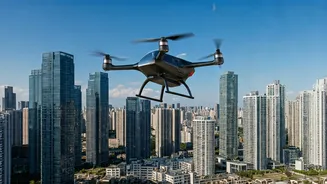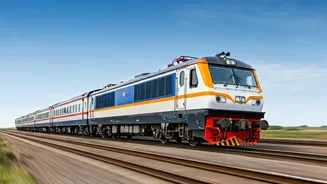Drone Taxi Vision
The Andhra Pradesh government is considering the introduction of drone taxis by 2027, marking a significant step towards modernizing its transport infrastructure.
This ambitious plan envisions a future where urban commuting is faster, more efficient, and potentially less congested. These autonomous aerial vehicles could reshape how people move within cities and between different areas, potentially reducing travel times and easing traffic issues that currently plague many urban centers. This initiative is a part of broader smart city strategies and focuses on leveraging technology to enhance the quality of life for its citizens and boost the state's economy by attracting investment in cutting-edge industries.
Technological Advancement
Drone taxis represent a convergence of several advanced technologies, mainly autonomous navigation, electric propulsion, and advanced air traffic management systems. These vehicles are designed to operate without a human pilot, relying on sophisticated software, sensors, and communication systems to navigate safely and efficiently. Electric propulsion is typically used to ensure quiet operation and reduce environmental impact. The integration of these vehicles requires a well-structured air traffic control system to prevent collisions and manage the flow of aerial traffic. This infrastructure must include ground stations, communication networks, and regulatory frameworks to ensure safety and operational efficiency. Furthermore, the development of these systems relies on continual advancements in artificial intelligence, battery technology, and material science.
Challenges & Hurdles
Implementing drone taxis faces various challenges, including regulatory hurdles, infrastructural needs, and public acceptance. Regulatory bodies must develop comprehensive safety standards and operational guidelines to govern these vehicles' usage, ensuring passenger safety and operational reliability. Furthermore, there's a need to build the infrastructure required to support drone taxi operations. This involves creating vertiports or designated landing and takeoff areas, as well as charging stations for electric-powered drones. Another essential aspect is addressing public concerns about safety, security, and the impact on urban landscapes. Educating the public about the technology and its benefits, demonstrating its safety through rigorous testing, and showing its economic potential are crucial steps to gain public support.
Economic Impact
The introduction of drone taxis has the potential to produce substantial economic benefits, including job creation, increased investment, and enhanced connectivity. The development and deployment of drone taxi systems could stimulate employment in manufacturing, maintenance, operations, and related sectors. Attracting investments in research, development, and infrastructure is also expected. Drone taxis can improve connectivity in remote areas, linking isolated communities with urban centers and facilitating access to essential services and opportunities. Moreover, they can contribute to the growth of industries such as tourism, logistics, and emergency services. This transformation can boost economic activities and stimulate sustainable urban development across Andhra Pradesh.
Future Implications
The adoption of drone taxis has broad implications for the future of urban transportation and could result in significant changes to how people live, work, and commute. As the technology matures and regulatory frameworks evolve, drone taxis could become integrated into existing transport networks, offering seamless multimodal transport solutions. Moreover, drone taxis can promote environmental sustainability by reducing greenhouse gas emissions and decreasing traffic congestion. The ability of drone taxis to access difficult terrains can be used in medical transportation and disaster response. The integration of this technology into everyday life can lead to an increase in efficiency and offer a better quality of life.
















